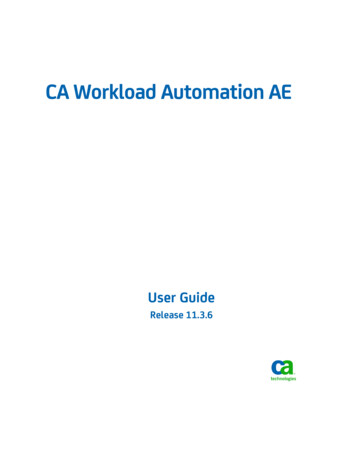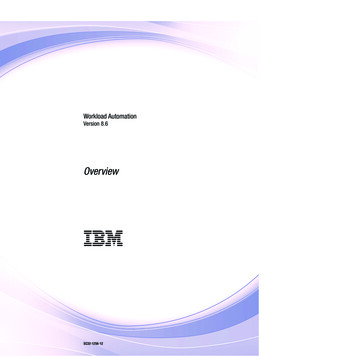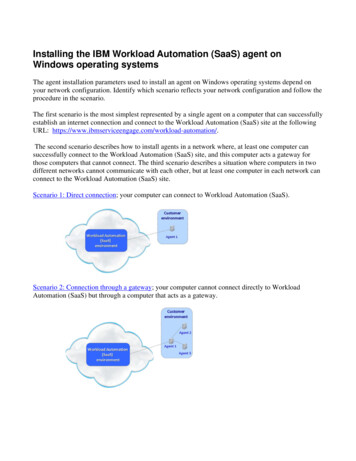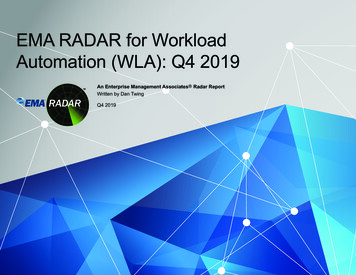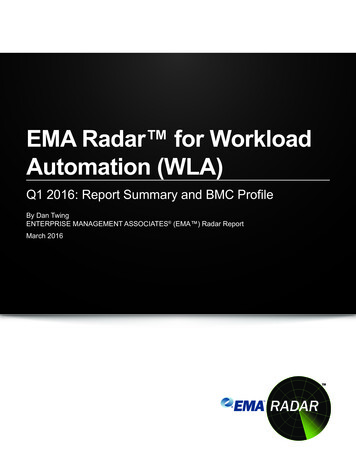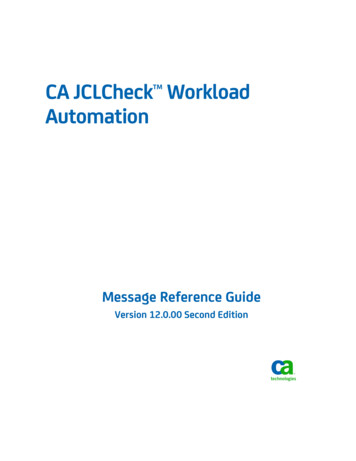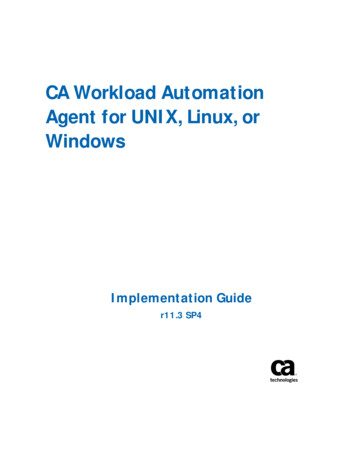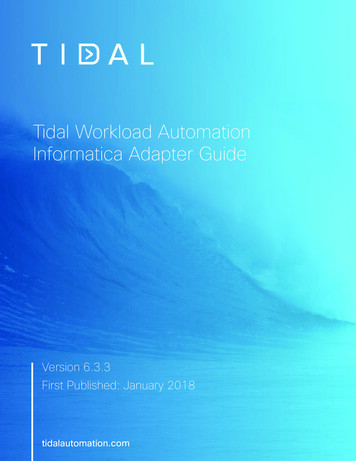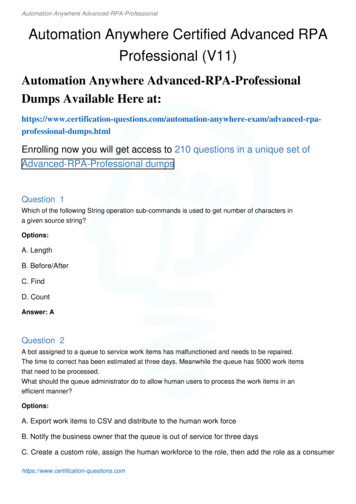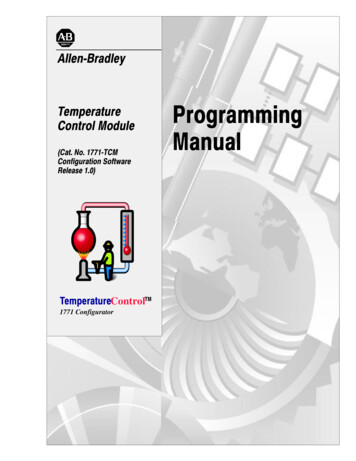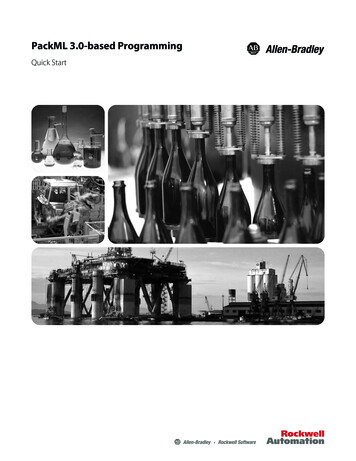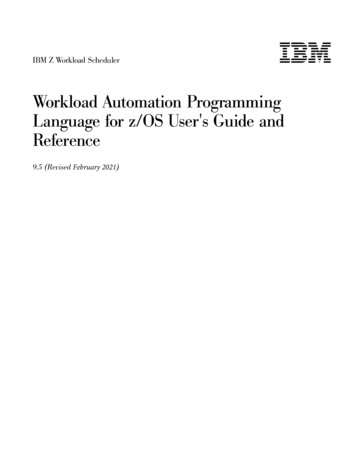
Transcription
IBM Z Workload SchedulerIBMWorkload Automation ProgrammingLanguage for z/OS User's Guide andReference9.5 (Revised February 2021)
IBM Z Workload SchedulerIBMWorkload Automation ProgrammingLanguage for z/OS User's Guide andReference9.5 (Revised February 2021)
NoteBefore using this information and the product it supports, read the information in "Notices".This edition applies to version 9, release 5, modification level 0 of IBM Z Workload Scheduler (program number5698-T08) and to all subsequent releases and modifications until otherwise indicated in new editions. Copyright IBM Corporation 2016.US Government Users Restricted Rights – Use, duplication or disclosure restricted by GSA ADP Schedule Contractwith IBM Corp. Copyright HCL Technologies Limited 2017, 2021.
IBM Z Workload Scheduler Contents viiContentsNote.iii.vList of Figures.xxiList of Tables. xxiiiPreface: About this publication.xxxiAccessibility. xxxiTechnical training.xxxiSupport information.xxxiConventions.xxxiiChapter 1: Overview.33Similarities to the Scheduling Operational Environment.34Version compatibility. 35Small product enhancements. 36Setting up the Workload Automation Programming Language environment. 37Language support.38Command language. 38Output files. 39Batch loader. 39 IBM Z Workload Scheduler PIF concepts. 40Data sources and structures. 40 IBM Z Workload Scheduler PIF requests. 42Chapter 2: Running Workload Automation Programming Language.45Running Workload Automation Programming Language in batch.46Running Workload Automation Programming Language as a load module. 48Running Workload Automation Programming Language within an online TSO session.50Running Workload Automation Programming Language on a started task workstation. 52Running Workload Automation Programming Language as a console command.54Specifying the subsystem. 55Using OUTPUT statements. 55Workload Automation Programming Language commands syntax.57Using comparators. 57Setting dates and times.58Termination, line numbers, and continuation.59Inserting comments in a statement.59Special resource and user field names. 60Special characters @, !, and #.60Knowing resource names.62Variable substitution.62
IBM Z Workload Scheduler Contents viiiUsing wildcards. 62Controlling the processing within Workload Automation Programming Language. 63Labeling Workload Automation Programming Language statements.64Defining subroutines.64Protecting against PIF failure.64Overriding Workload Automation Programming Language defaults. 65Message log. 65Chapter 3: Core programming commands. 67CALL – Execute external program, subroutine, or variable.67DISPLAY – Echo information to SYSTPRT.68DO and END – Block and Loop commands. 68Block DO. 69Repeat DO loop. 69Iterative DO loop.69DO While loop. 70DO Until loop. 71DO Forever loop.71DROP – Drop elements from memory. 72EXIT – Terminate processing. 72FILTER – Post process selected records to reduce output. 72IF-THEN-ELSE – Conditional execution. 74INCLUDE – Include code from other data sets or members to be run. 75ITERATE – Proceed to the next iteration of current loop.76LEAVE – Exit the current loop.76LOG – Echo information to the log. 76MERGE – Merge SAVELIST output.77NOACT – Peform no action. 77OPTIONS – Define run time options and PIF requests. 78OUTPUT – Define output record. 78Specifying output destinations.80Setting additional fields. 80READ – Read an external file or the external data queue. 81RETURN – Exit the subroutine. 81SETMAX – Manipulate the maximum return code.81SETSEV – Set message severity.82SHOW – Show diagnostic information. 83SHOW FILES – Display files allocated to Workload Automation Programming Language.83 SHOW OBJECT – Display the object structure of an IBM Z Workload Scheduler record. 84SHOW OPTIONS – Display Workload Automation Programming Language OPTIONS currentlyeffective. 86SHOW RC – Display return codes. 87SHOW SAVELIST – Display the contents of a SAVELIST. 87SHOW SPE – Display active Small Product Enhancements.88SHOW SYSINFO – Display information about the LPAR. 88SHOW SUBSYSTEM – Display controller information.89SHOW USRF – Display Operation User Fields for this job. 89SHOW VARIABLES – Display current variable values. 90SUBROUTINE – Indicate the start of a subroutine. 90TRANSLATE – Define rules for life-cycle translation. 90WAIT – Delay before continuing with the next command.92WRITE – Echo information to a file or the external data queue. 92Chapter 4: Workload Automation Programming Language functions. 93
IBM Z Workload Scheduler Contents ix@ - Date logic function. 93@CMD and @JCL – Check RC of previous command or JCL step. 94@LOG – Return the date and time in EQQYLOG format.96@V – Return the value of a named variable. 96Chapter 5: Data Access commands based on PIF. 97DELETE – Delete object from database or plan. 97DELETE AD – Application Definition.98DELETE AWSCL – All Workstations Closed.98DELETE CL – Calendar. 98DELETE CPCOND – Condition.98DELETE CPLAT – Operation user-defined late information.99DELETE CPOC – Current Plan Occurrence. 99DELETE CPOCPRE – Current Plan Occurrence Predecessor. 99DELETE CPOCSUC – Current Plan Occurrence Successor.99DELETE CPOP – Current Plan Operation. 99DELETE CPPRE – Current Plan Predecessor.99DELETE CPSIMP – Conditional predecessor.100DELETE CPSR – Current Plan Operation Special Resource.101DELETE CPSUC – Current Plan Successor. 101DELETE CPUSRF – User Field.101DELETE ETT – Event Trigger. 102DELETE IVL – Current Plan Workstation Interval.102DELETE JCLV – JCL Variable Table. 102DELETE JL – Job Log. 102DELETE JS – Current Plan JCL. 103DELETE LTOC – Long-Term Plan Occurrence.103DELETE LTCPRE – LTP Conditional Predecessor. 103DELETE LTPRE – Long-Term Plan Predecessor. 103DELETE OI – Operator Instruction.104DELETE PR – Period. 104DELETE SR – Special Resource. 104DELETE VIVL – CP Virtual Workstation Interval. 104DELETE WS – Workstation. 105DELETE WSV – Virtual workstation destination. 105EXECUTE – Commit updates to the Current Plan. 105 INIT – Initialize communication with IBM Z Workload Scheduler. 106INIT subsystem.106INSERT – Add objects into the plan. 107INSERT CPCOND – Current Plan Condition. 108INSERT CPLAT – Operation User-defined Late Information.108INSERT CPOC – Current Plan Occurrence.109INSERT CPOCPRE – Current Plan Occurrence Predecessor. 109INSERT CPOCSUC – Current Plan Occurrence Successor. 110INSERT CPOP – Current Plan Operation. 110INSERT CPPRE – Current Plan Predecessor. 112INSERT CPSAI – Current Plan System Automation Info.112INSERT CPSIMP – Current Plan Conditional Predecessor. 112INSERT CPSR – Current Plan Operation Special Resource. 114INSERT CPSUC – Current Plan Successor.114INSERT CPUSRF – User Field. 114INSERT IVL – Current Plan Workstation Interval.115INSERT JCLPREP – JCL Preparation.
IBM Z Workload Scheduler Workload Automation Programming Language for z/OS User's Guide and Reference 9.5 (Revised February 2021) IBM. Note Before using this information and th
